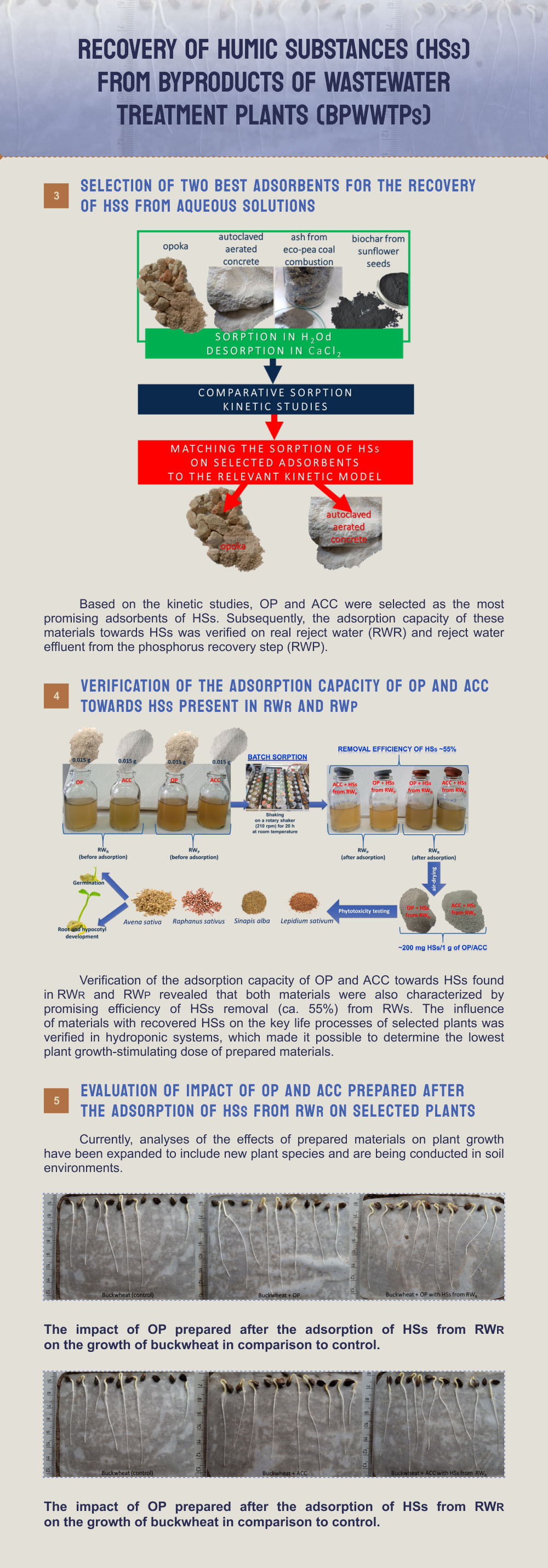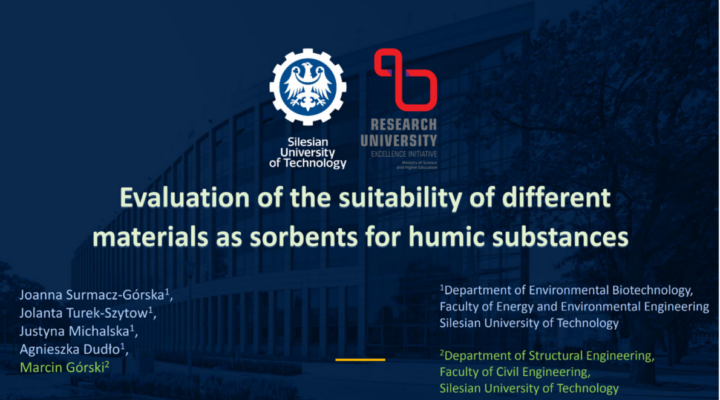Since the characterization of compositional parameters of humic substances (HSs)
is important to understand their behavior in wastewater treatment plant systems (WWTPSs), four methods have been verified for the determination of the concentration of such compounds in aqueous solutions, including UV-Vis and fluorescence spectrophotometry and measurement of the chemical oxygen demand (COD) and total organic carbon (TOC). Among them, the UV-Vis spectrophotometry was selected as an effective tool for the evaluation of the structure, characteristics, and usage potential of HSs.
Twenty-five materials, including organic materials (also waste), inorganic materials (both minerals and waste), and materials popular in horticulture were tested in terms of their applicability as efficient adsorbents of model humic substances (MHSs) and fulvic acids (MFAs) present in aqueous solution. This allowed the selection of the three most effective adsorbents of MHSs, including opoka (OP), autoclaved aerated concrete (AAC), and ash from eco-pea coal combustion (AECC) with adsorption efficiencies of 78, 67, and 64%, and one most effective adsorbent of MFAs, namely biochar from sunflower seeds (BSS) with adsorption efficiency of 25%. For all studied potential adsorbents, the mechanism of adsorption of HSs has been described. The proposed adsorption mechanisms revealed the differences in the nature of this process, depending on the material used as the adsorbent of HSs.
Based on the kinetic studies, OP and ACC were selected as the most promising adsorbents of HSs. Subsequently, the adsorption capacity of these materials towards HSs was verified on real reject water (RWR) and reject water effluent from the phosphorus recovery step (RWP). Both types of reject waters (RWs) have been characterized in terms of their composition that indicated the dominance of fulvic acids (FAs) in such wastes, which amounted to 89 and 32% of their organic matter (OM), respectively.
Although preliminary kinetic studies with MHCs have shown that the highest adsorption capacity of OP and ACC, and simultaneously the highest removal efficiency of MHCs was achieved when the employed dosage of adsorbents was 0.02 g, the adsorption studies conducted using RWR revealed that the decrease of the dose of selected materials to 0.015 g has given better results. Therefore, the adsorbent dose of 0.015 g instead of 0.02 g was applied for the kinetic studies related to the recovery of HSs from RWR and RWP.
Verification of the adsorption capacity of OP and ACC towards HSs found in RWR and RWP revealed that both materials were also characterized by promising efficiency of HSs removal (ca. 55%) from RWs. Moreover, the spectrophotometric analyses of coloured organic matter (CDOM) remaining in the RWR and RWP after the adsorption process revealed that the adsorption of high molecular weight fractions of humic fractions prevailed over that of low molecular weight fractions of HSs. Similar observation were made in the case of the adsorption mechanisms of MHSs. Despite promising adsorption capacity, OP and ACC were only able to release only 18 and 19% of HSs adsorbed from RWR on their surface during 20 h, however, the desorption of HSs originated from RWP from surveyed materials was two times lower.
From the application point of view, RWR was recognized to be a better location for HSs recovery. Not only the adsorption carried out in this waste was faster but it also enabled the simultaneous recovery of phosphorus, which may improve the quality of produced material. The analysis of the OM content of raw materials applied for adsorption of HSs from RWR and those prepared as a result the process revealed a significant increase in the value of this parameter. In comparison to the raw OP and ACC that were characterized by negligible content of OM (0.38 and 3.63%, respectively), materials obtained after the adsorption HSs from RWR were characterized by nearly 14 times and 2 times higher value of this parameter, respectively.
The influence of materials with recovered HSs on the key life processes of selected plants, including mustard, radish, sorghum, and cress was verified in hydroponic systems, which made it possible to determine the lowest plant growth-stimulating dose of prepared materials. Currently, analyses of the effects of prepared materials on plant growth have been expanded to include new plant species and are being conducted in soil environments.
Activities:The results obtained within the project were presented on the following conferences:
| Title of presented work | Authors | Name of the conference/ seminar | Date and place |
| Evaluation of the suitability of different materials as sorbents for humic substances | Joanna Surmacz-Górska, Jolanta Turek-Szytow, Justyna Michalska, Agnieszka Dudło, Marcin Górski | Scientific Seminar of the Priority Research Area Climate and Environmental Protection, Modern Energy (POB6). Sub-area 3: Circular economy “Recovery and use of substances or energy from waste” On-line seminar at Silesian University of Technology |
March 22, 2022, Gliwice, Poland (on-line) |
| Selection of mineral sorbents for sorption of humic substances | Justyna Michalska, Jolanta Turek-Szytow, Agnieszka Dudło Joanna Surmacz-Górska | IWA Wastewater, Water and Resource Recovery Conference 2022 SImultaneous Workshop on Recovery of Energy, organics and Nutrients and generation of valuable products from municipal wastewater |
April 10 – 13, 2022, Poznan, Poland (on-line) |
| Evaluation of the suitability of different concretes as adsorbents for humic substances |
Justyna Michalska, Jolanta Turek-Szytow, Agnieszka Dudło Joanna Surmacz-Górska | EFB Spring Congress, Symposium on Biotechnology for Resource Recovery |
May 10 – 13, 2022, (on-line) |
| The use of mineral waste materials as carriers of humic substances and evaluation of the possibility of their use as agents for improving the properties of soils | Justyna Michalska, Jolanta Turek-Szytow, Agnieszka Dudło Joanna Surmacz-Górska | Workshop of the Scientific Thematic Network of Environmental Biotechnology “Enbionet” |
June 27-28, 2022, Gliwice, Poland
|
| Evaluation of the possibility of using mineral waste materials in sorption process of humic substances | Justyna Michalska, Jolanta Turek-Szytow, Agnieszka Dudło Joanna Surmacz-Górska | Workshop of the Scientific Thematic Network of Environmental Biotechnology “Enbionet” |
June 27-28, 2022, Gliwice, Poland
|
| Evaluation of the possibility of application of concrete as a carrier of humic substances extracted from the sewage sludge – the impact on soil environment |
Justyna Michalska, Jolanta Turek-Szytow, Agnieszka Dudło Joanna Surmacz-Górska | EFB Virtual Conference | October 4-5, 2022, (on-line) |





